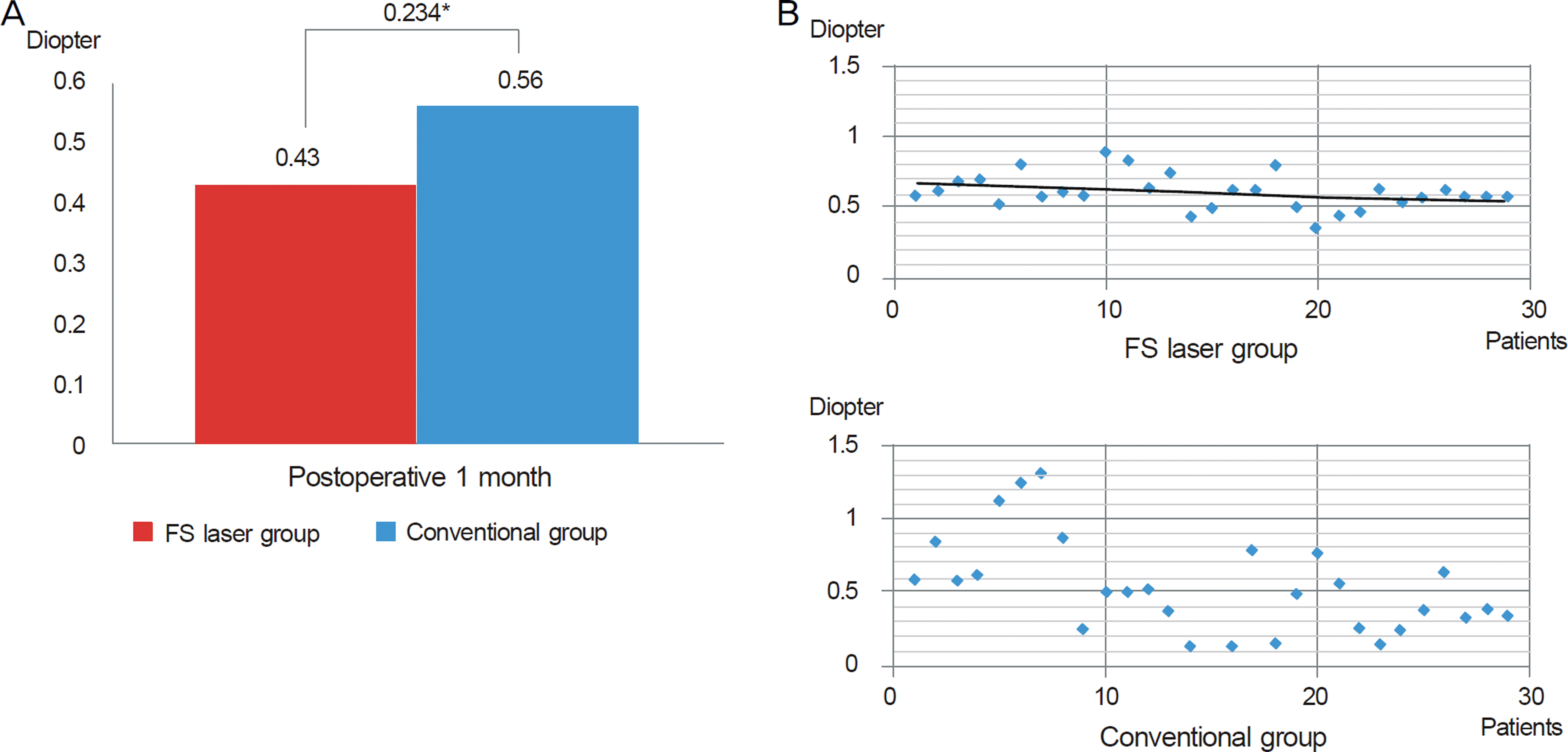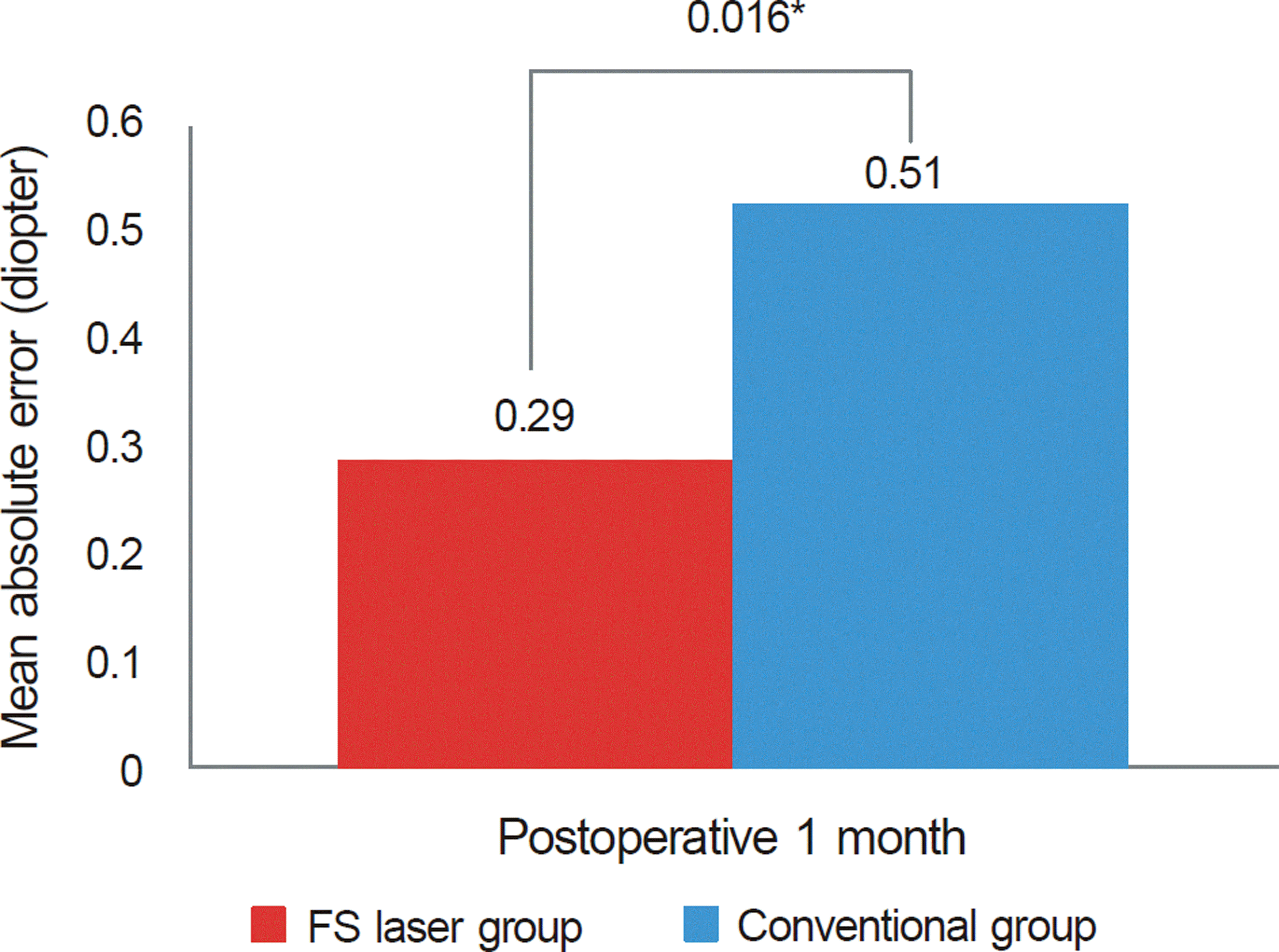Abstract
Purpose
To evaluate the surgical results and efficacy of laser refractive cataract surgery with a femtosecond laser com-pared with conventional phacoemulsification.
Methods
Thirty-one eyes from 31 patients underwent laser refractive cataract surgery (femtosecond laser group), and conventional cataract surgery with phacoemulsification was performed in 30 eyes from 30 patients (conventional group). Best corrected visual acuity, spherical equivalent, surgical induced astigmatism, corneal and ocular astigmatism, total high order aberration, Strehl ratio, objective scatter index, diameter of continuous curvilinear capsulorrhexis (CCC), distance from visual axis to the center of CCC, intraocular lens (IOL) tilt, mean absolute error, effective phaco time, average phaco power and operation time were measured to compare the 2 groups.
Results
No significant differences were found between best corrected visual acuity, spherical equivalent, surgical induced astigmatism, corneal and ocular astigmatism, total high order aberration, Strehl ratio, objective scatter index, mean abso-lute error, effective phaco time, average phaco power or operation time. Significant differences were found in the diameter of CCC, distance from visual axis to the center of CCC, and IOL tilt.
Go to : 
References
1. Fine IH. Architecture and construction of a self-sealing incision for cataract surgery. J Cataract Refract Surg. 1991; 17:Suppl. 672–6.

2. Gimbel HV, Neuhann T. Development, advantages, and methods of the continuous circular capsulorhexis technique. J Cataract Refract Surg. 1990; 16:31–7.

3. Colvard DM, Dunn SA. Intraocular lens centration with con-tinuous tear capsulotomy. J Cataract Refract Surg. 1990; 16:312–4.

4. Kránitz K, Miháltz K, Sándor GL. . Intraocular lens tilt and de-centration measured by scheimpflug camera following manual or femtosecond laser-created continuous circular capsulotomy. J Refract Surg. 2012; 28:259–63.

5. Holladay JT, Cravy TV, Koch DD. Calculating the surgically in-duced refractive change following ocular surgery. J Cataract Refract Surg. 1992; 18:429–43.

6. Kránitz K, Takacs A, Miháltz K. . Femtosecond laser capsu-lotomy and manual continuous curvilinear capsulorrhexis parame-ters and their effects on intraocular lens centration. J Refract Surg. 2011; 27:558–63.

7. Nagy Z, Takacs A, Filkorn T, Sarayba M. Initial clinical evaluation of an intraocular femtosecond laser in cataract surgery. J Refract Surg. 2009; 25:1053–60.

8. Miháltz K, Knorz MC, Alió JL. . Internal aberrations and opti-cal quality after femtosecond laser anterior capsulotomy in cataract surgery. J Refract Surg. 2011; 27:711–6.

9. Nagy ZZ, Kránitz K, Takacs AI. . Comparison of intraocular lens decentration parameters after femtosecond and manual capsulotomies. J Refract Surg. 2011; 27:564–9.

10. Filkorn T, Kovács I, Takács A. . Comparison of IOL power cal-culation and refractive outcome after laser refractive cataract sur-gery with a femtosecond laser versus conventional phacoe- mulsification. J Refract Surg. 2012; 28:540–4.
11. Martínez-Roda JA, Vilaseca M, Ondategui JC. . Optical qual-ity and intraocular scattering in a healthy young population. Clin Exp Optom. 2011; 94:223–9.
12. Nochez Y, Majzoub S, Pisella PJ. Effect of residual ocular spher-ical aberration on objective and subjective quality of vision in pseudophakic eyes. J Cataract Refract Surg. 2011; 37:1076–81.

13. Holladay JT, Piers PA, Koranyi G. . A new intraocular lens de-sign to reduce spherical aberration of pseudophakic eyes. J Refract Surg. 2002; 18:683–91.

14. Piers PA, Weeber HA, Artal P, Norrby S. Theoretical comparison of aberration-correcting customized and aspheric intraocular lenses. J Refract Surg. 2007; 23:374–84.

15. Marques FF, Marques DM, Osher RH, Osher JM. Fate of anterior capsule tears during cataract surgery. J Cataract Refract Surg. 2006; 32:1638–42.

16. Ohmi S. Decentration associated with asymmetric capsular shrink-age and intraocular lens size. J Cataract Refract Surg. 1993; 19:640–3.

17. Lakshminarayanan V, Enoch JM, Raasch T. . Refractive changes induced by intraocular lens tilt and longitudinal displacement. Arch Ophthalmol. 1986; 104:90–2.

18. Atchison DA. Refractive errors induced by displacement of intra-ocular lenses within the pseudophakic eye. Optom Vis Sci. 1989; 66:146–52.

19. Erickson P. Effects of intraocular lens position errors on post-operative refractive error. J Cataract Refract Surg. 1990; 16:305–11.

20. Kozaki J, Tanihara H, Yasuda A, Nagata M. Tilt and decentration of the implanted posterior chamber intraocular lens. J Cataract Refract Surg. 1991; 17:592–5.

21. Korynta J, Bok J, Cendelin J. Changes in refraction induced by change in intraocular lens position. J Refract Corneal Surg. 1994; 10:556–64.

22. Akahoshi T. Phaco prechop: manual nucleofracture prior to phacoemulsification. Op Tech Cataract Ref Surg. 1998; 1:69–91.
23. Bencić G, Zorić-Geber M, Sarić D. . Clinical importance of the lens opacities classification system III (LOCS III) in phaco- emulsification. Coll Antropol. 2005; 29 Suppl. 1:91–4.
Go to : 
 | Figure 1.Figure 1. Comparison (A) and distribution (B) of surgically induced astigmatism between laser refractive cataract surgery with a femtosecond laser and conventional phacoemulsification at postoperative 1 month. *p-value = statistical significance was calculated by Mann-Whitney test. |
 | Figure 2.Preoperative and postoperative parameters (Strehl ratio (A), Objective scatter index (B)) in Optical Quality Analysis System between laser refractive cataract surgery with a femtosecond laser and conventional phacoemulsification at postoperative 1 month. * p-value = statistical significance was calculated by Mann-Whitney test. |
 | Figure 3.Comparison (A) and dis-tribution (B) of curvilinear capsu-lorrhexis size which was meas-ured by Casia SS-1000 OCT be-tween laser refractive cataract sur-gery with a femtosecond laser and conventional phacoemulsification at postoperative 1 month (B). (A) Diameter of continuous curvilinear capsulorrhexis (mm). (B) Distribution of diameter (mm). *p-value = stat-istical significance was calculated by Mann-Whitney test. |
 | Figure 4.The distance from visual axis to the center of continuous curvilinear capsulorrhexis (A) and Intraocular lens positioning (horizontal tilt) (B) between laser refractive cataract surgery with a femtosecond laser and conventional phacoemulsification at post-operative 1 month (B). * p-value = statistical significance was calculated by Mann-Whitney test. |
 | Figure 5.Difference between predicted and achieved post-operative spherical equivalent refraction. Mean absolute error was analyzed 1 month after surgery. * p-value = statistical sig-nificance was calculated by Mann-Whitney test. |
Table 1.
Preoperative characteristics of eyes for laser refractive cataract surgery with a femtosecond laser group and conventional phacoemulsification group
Table 2.
Preoperative and postoperative visual acuity
Table 3.
Preoperative and postoperative ocular aberrations were measured at the 4.0 mm and 6.0 mm optical zone. Aberration pa-rameters were included ocular astigmatism, corneal astigmatism, and total high order aberration by KR-1W aberrometer
Table 4.
Effective phaco time, average phaco power, operation time were analyzed between laser refractive cataract surgery with a femtosecond laser and conventional phacoemulsification




 PDF
PDF ePub
ePub Citation
Citation Print
Print


 XML Download
XML Download